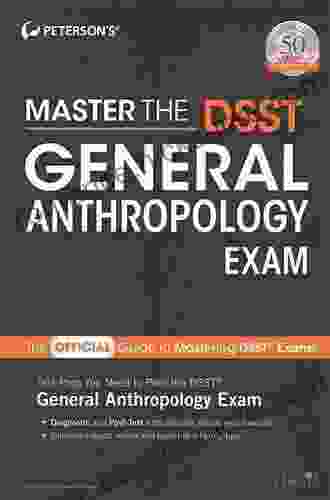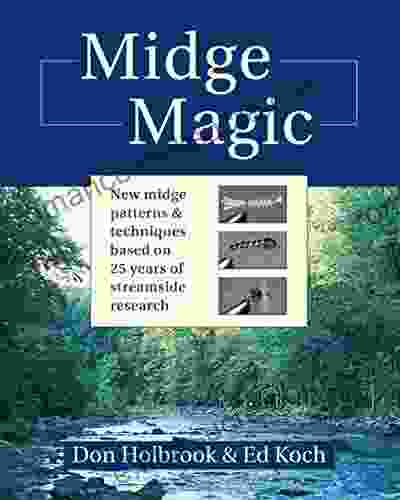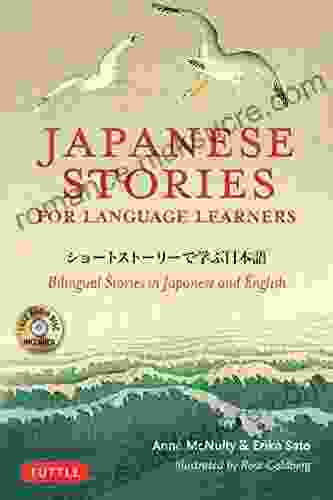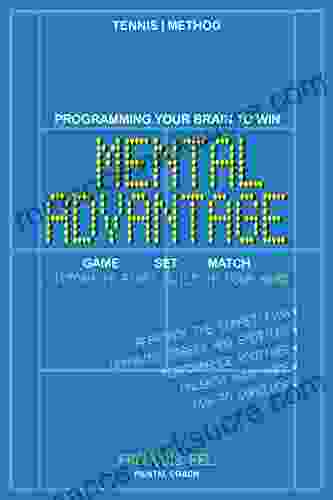Master the DSST General Anthropology Exam: A Comprehensive Guide

The DSST General Anthropology Exam is a college-level examination that assesses your knowledge of the field of anthropology. The exam is divided into four content areas:
- Biological Anthropology
- Cultural Anthropology
- Linguistic Anthropology
- Archaeology
The DSST General Anthropology Exam is a challenging exam, but it is also a great way to earn college credit for your knowledge of anthropology. If you are planning to take the exam, it is important to prepare thoroughly. This guide will provide you with everything you need to know to master the DSST General Anthropology Exam.
The DSST General Anthropology Exam is a multiple-choice exam consisting of 100 questions. The exam is timed, and you will have 120 minutes to complete it. The questions are divided into four content areas, with each content area being weighted equally.
5 out of 5
| Language | : | English |
| File size | : | 1056 KB |
| Text-to-Speech | : | Enabled |
| Screen Reader | : | Supported |
| Enhanced typesetting | : | Enabled |
| Print length | : | 90 pages |
The following table provides a breakdown of the content areas and the number of questions in each area:
| Content Area | Number of Questions | |---|---| | Biological Anthropology | 25 | | Cultural Anthropology | 25 | | Linguistic Anthropology | 25 | | Archaeology | 25 |
To pass the DSST General Anthropology Exam, you must score at least a 500 on a scale of 600.
The best way to prepare for the DSST General Anthropology Exam is to study the content areas thoroughly. You can do this by reading textbooks, taking online courses, or attending study groups. It is also important to practice taking practice exams. This will help you get familiar with the format of the exam and the types of questions that you can expect.
Here are some additional study tips:
- Create a study schedule. This will help you stay on track and ensure that you cover all of the content areas.
- Set realistic goals. Don't try to learn everything all at once. Break down the material into smaller chunks and focus on one content area at a time.
- Take practice exams. This is the best way to see how well you are prepared for the exam.
- Get enough sleep. This will help you stay focused and alert on test day.
- Eat a healthy breakfast. This will give you the energy you need to perform well on the exam.
The following practice questions are designed to help you get a feel for the types of questions that you can expect on the DSST General Anthropology Exam.
Biological Anthropology
Which of the following is a characteristic of hominids? (a) Bipedalism (b) Opposable thumbs (c) Large brains (d) All of the above
What is the process by which humans evolved from apes? (a) Natural selection (b) Sexual selection (c) Genetic drift (d) Mutation
Cultural Anthropology
Which of the following is a function of culture? (a) To provide a sense of identity (b) To regulate behavior (c) To transmit knowledge (d) All of the above
What is the difference between emic and etic perspectives? (a) Emic perspectives are insider perspectives, while etic perspectives are outsider perspectives. (b) Emic perspectives are objective perspectives, while etic perspectives are subjective perspectives. (c) Emic perspectives are based on observation, while etic perspectives are based on interpretation. (d) Emic perspectives are focused on the present, while etic perspectives are focused on the past.
Linguistic Anthropology
Which of the following is a characteristic of language? (a) It is arbitrary. (b) It is systematic. (c) It is creative. (d) All of the above
What is the difference between a phoneme and a morpheme? (a) A phoneme is a unit of sound, while a morpheme is a unit of meaning. (b) A phoneme is a written symbol, while a morpheme is a spoken sound. (c) A phoneme is a part of a word, while a morpheme is a whole word. (d) A phoneme is a unit of grammar, while a morpheme is a unit of vocabulary.
Archaeology
Which of the following is a method used by archaeologists? (a) Excavation (b) Survey (c) Dating (d) All of the above
What is the difference between a primary source and a secondary source? (a) A primary source is an original document, while a secondary source is a document that interprets the original document. (b) A primary source is a document that is written by the people who were involved in the events being studied, while a secondary source is a document that is written by someone who was not involved in the events being studied. (c) A primary source is a document that is written in the present tense, while a secondary source is a document that is written in the past tense. (d) A primary source is a document that is written in the first person, while a secondary source is a document that is written in the third person.
The DSST General Anthropology Exam is a challenging exam, but it is also a great way to earn college credit for your knowledge of anthropology. If you are planning to take the exam, it is important to prepare thoroughly. By following the tips in this guide, you can increase your chances of success on the exam.
5 out of 5
| Language | : | English |
| File size | : | 1056 KB |
| Text-to-Speech | : | Enabled |
| Screen Reader | : | Supported |
| Enhanced typesetting | : | Enabled |
| Print length | : | 90 pages |
Do you want to contribute by writing guest posts on this blog?
Please contact us and send us a resume of previous articles that you have written.
 Fiction
Fiction Non Fiction
Non Fiction Romance
Romance Mystery
Mystery Thriller
Thriller SciFi
SciFi Fantasy
Fantasy Horror
Horror Biography
Biography Selfhelp
Selfhelp Business
Business History
History Classics
Classics Poetry
Poetry Childrens
Childrens Young Adult
Young Adult Educational
Educational Cooking
Cooking Travel
Travel Lifestyle
Lifestyle Spirituality
Spirituality Health
Health Fitness
Fitness Technology
Technology Science
Science Arts
Arts Crafts
Crafts DIY
DIY Gardening
Gardening Petcare
Petcare Michael R Shea
Michael R Shea Morgan Rice
Morgan Rice Michael Bamberger
Michael Bamberger Catherine Ann Clemett
Catherine Ann Clemett Ryan Pyle
Ryan Pyle Yossi Ghinsberg
Yossi Ghinsberg Kara Thomas
Kara Thomas Colin Gordon
Colin Gordon Vincent Chidindu Asogwa
Vincent Chidindu Asogwa Scott Murr
Scott Murr Charles Edward Chapel
Charles Edward Chapel Doris Barren
Doris Barren Eknath Easwaran
Eknath Easwaran Hugh Neill
Hugh Neill Sarah Marquis
Sarah Marquis Edward Dutton
Edward Dutton Ken Blanchard
Ken Blanchard Eva Maria Zurhorst
Eva Maria Zurhorst Karl A Pillemer
Karl A Pillemer Justin M Jacobs
Justin M Jacobs Lucy Rees
Lucy Rees Michael Whitehead
Michael Whitehead Stian Christophersen
Stian Christophersen Kenny Moore
Kenny Moore Michael Pearl
Michael Pearl Jen L Grey
Jen L Grey William Kennedy
William Kennedy Lori L Tharps
Lori L Tharps Monique Joiner Siedlak
Monique Joiner Siedlak Rick Burgess
Rick Burgess Gershon Ben Keren
Gershon Ben Keren Tamara Tobias
Tamara Tobias Gary L Greenwald
Gary L Greenwald Christopher G Fairburn
Christopher G Fairburn Zainab Jagot Ahmed
Zainab Jagot Ahmed Dan Sheeks
Dan Sheeks Oscar Levin
Oscar Levin E Ink Utilizer
E Ink Utilizer Eric Mayost
Eric Mayost Naomi Chunilal
Naomi Chunilal Gooseberry Patch
Gooseberry Patch Matt Omasta
Matt Omasta Maryana Vollstedt
Maryana Vollstedt Oliver T Spedding
Oliver T Spedding Phil Bourjaily
Phil Bourjaily Christopher M Kelty
Christopher M Kelty Sarah S Richardson
Sarah S Richardson Jessica Rohrer
Jessica Rohrer Nicholas Tomalin
Nicholas Tomalin Jolene Brighten
Jolene Brighten R F Egerton
R F Egerton Michel Boivin
Michel Boivin Matt Landry
Matt Landry Stephen Cleary
Stephen Cleary Tim Freke
Tim Freke Emma Jane Unsworth
Emma Jane Unsworth Christopher Ives
Christopher Ives Rebecca Anne Bailey
Rebecca Anne Bailey Rachelle Doorley
Rachelle Doorley Robert F Devellis
Robert F Devellis Matt Heid
Matt Heid Mohammed Musthafa Soukath Ali
Mohammed Musthafa Soukath Ali Dolly Chugh
Dolly Chugh Judy Sierra
Judy Sierra Walter Sosa Escudero
Walter Sosa Escudero Celine Clive
Celine Clive George Gamow
George Gamow Frank Joseph
Frank Joseph Robert Yang
Robert Yang Eamon Duffy
Eamon Duffy Heather Won Tesoriero
Heather Won Tesoriero Nicholas R Finamore
Nicholas R Finamore Esther Joos Esteban
Esther Joos Esteban Michael Daugherty
Michael Daugherty Lyle D Broemeling
Lyle D Broemeling Donna Shaw
Donna Shaw Carmen Davenport
Carmen Davenport Carlos Pestana
Carlos Pestana Seth Godin
Seth Godin Rick Monday
Rick Monday Magdalena Jackowska
Magdalena Jackowska Gene Luen Yang
Gene Luen Yang Dr Ray Makar
Dr Ray Makar David M Levine
David M Levine Glenn Doman
Glenn Doman Mark Harmon
Mark Harmon Dr N Rama Chandran
Dr N Rama Chandran Vanessa Len
Vanessa Len Confident Golfer
Confident Golfer Dr Harmony
Dr Harmony Mark Levi
Mark Levi Karen M Masterson
Karen M Masterson David Stanley
David Stanley Dedrick L Moone
Dedrick L Moone Hannah Fry
Hannah Fry Diane Ackerman
Diane Ackerman John Durant
John Durant Jack Whyte
Jack Whyte Mark Stewart
Mark Stewart Michael A Tompkins
Michael A Tompkins John Green
John Green Laurie Halse Anderson
Laurie Halse Anderson Jay Mccullough
Jay Mccullough Lily Collins
Lily Collins Tomoko Fuse
Tomoko Fuse James Cordrey
James Cordrey Robert Kratz
Robert Kratz Scott Strother
Scott Strother Fred Zeglin
Fred Zeglin Jeremy Laszlo
Jeremy Laszlo Candace Couch
Candace Couch Michael Walker
Michael Walker Reda Waaziz
Reda Waaziz Patrick Vinton Kirch
Patrick Vinton Kirch Stephen Harrison
Stephen Harrison Darren Levine
Darren Levine Patrick F Mcmanus
Patrick F Mcmanus A R Vasishtha
A R Vasishtha Joanna Sayago Golub
Joanna Sayago Golub Thomas Celentano
Thomas Celentano Jeremy Keeshin
Jeremy Keeshin Sean Moloney
Sean Moloney Josh Kirchner
Josh Kirchner H Keith Melton
H Keith Melton Igor Dudukchan
Igor Dudukchan S L Watson
S L Watson Kate Chenery Tweedy
Kate Chenery Tweedy Dagogo Altraide
Dagogo Altraide David And Avi Epstein
David And Avi Epstein Rich Dossan
Rich Dossan Juan Carlos Jc Santana
Juan Carlos Jc Santana Jennifer Ward
Jennifer Ward Stedman Graham
Stedman Graham Rob Iliffe
Rob Iliffe Sigmund Freud
Sigmund Freud Cheikh Anta Diop
Cheikh Anta Diop Patricia Irwin Johnston
Patricia Irwin Johnston Patricia Raybon
Patricia Raybon Jordon Greene
Jordon Greene Marina Umaschi Bers
Marina Umaschi Bers Schalk Holloway
Schalk Holloway Judah Phillips
Judah Phillips Danya Kukafka
Danya Kukafka Karl White
Karl White Carol Anderson
Carol Anderson Dominic O Brien
Dominic O Brien Mark L Prophet
Mark L Prophet Martin Mahner
Martin Mahner Robin Arzon
Robin Arzon Lisa Kenney
Lisa Kenney Om Krishna Uprety
Om Krishna Uprety Rachael Scdoris
Rachael Scdoris David Estes
David Estes Ibram X Kendi
Ibram X Kendi James Weldon Johnson
James Weldon Johnson Lynn Mann
Lynn Mann Roman Dial
Roman Dial Blake Healy
Blake Healy Nicola Yoon
Nicola Yoon Corinne Maier
Corinne Maier Christopher Ryan
Christopher Ryan Wayne Evans
Wayne Evans Nicole Unice
Nicole Unice Nicholas Bjorn
Nicholas Bjorn Rachel Ignotofsky
Rachel Ignotofsky Daniel G Amen
Daniel G Amen Lilia Tarawa
Lilia Tarawa Nick O Hern
Nick O Hern Krishna Godhania
Krishna Godhania Ken Alder
Ken Alder General
General Kelly St Clare
Kelly St Clare Monica Swanson
Monica Swanson James Van Praagh
James Van Praagh Pardis Mahdavi
Pardis Mahdavi Mary E Hagle
Mary E Hagle Karen J Bun
Karen J Bun Paul Bellow
Paul Bellow Mockingbird The Mincing
Mockingbird The Mincing Rev Cain
Rev Cain Rachel Johnson Greer
Rachel Johnson Greer Cory Mccartney
Cory Mccartney Graham Hancock
Graham Hancock Eriko Sato
Eriko Sato Catherine Carrigan
Catherine Carrigan David J Helfand
David J Helfand Karyn D Hall
Karyn D Hall Don Holbrook
Don Holbrook John Sandford
John Sandford Mary Jackson
Mary Jackson Steve Raymond
Steve Raymond Shefali Tsabary
Shefali Tsabary Helen Saul Case
Helen Saul Case Jeff Steiner
Jeff Steiner Summary Genie
Summary Genie Silvanus P Thompson
Silvanus P Thompson Gregory A Loew
Gregory A Loew Marc Lipson
Marc Lipson Gretchen Reynolds
Gretchen Reynolds Course Hero
Course Hero Orangepen Publications
Orangepen Publications Scott Weidensaul
Scott Weidensaul Tim J Wise
Tim J Wise Baby Professor
Baby Professor Toney Allman
Toney Allman Molly Wizenberg
Molly Wizenberg Tashie Bhuiyan
Tashie Bhuiyan Julie Johnson
Julie Johnson Peterson S
Peterson S Carlos Magdalena
Carlos Magdalena Sergey K Aityan
Sergey K Aityan Clyde E Fant
Clyde E Fant Jay L Devore
Jay L Devore Steve Burrows
Steve Burrows Morton D Davis
Morton D Davis Robert Allans
Robert Allans Daniel Zwillinger
Daniel Zwillinger Tom Coyne
Tom Coyne Marilyn J Hockenberry
Marilyn J Hockenberry Sadie Radinsky
Sadie Radinsky Jeffrey Hoffstein
Jeffrey Hoffstein John Blair
John Blair 1st Edition Kindle Edition
1st Edition Kindle Edition Jonathan Malesic
Jonathan Malesic Eve Porinchak
Eve Porinchak Linda E Mccuistion
Linda E Mccuistion Clint Orr
Clint Orr Wendy M Reinke
Wendy M Reinke Platinum Creation
Platinum Creation Reid Oslin
Reid Oslin Marcelo Gleiser
Marcelo Gleiser Jamie Marich
Jamie Marich Raymond G Miltenberger
Raymond G Miltenberger Tiffany Jewell
Tiffany Jewell Henry E Mejia
Henry E Mejia Kenneth P Langer
Kenneth P Langer Rick Townsend
Rick Townsend Nancy Carter Crump
Nancy Carter Crump Lane Pederson
Lane Pederson Emily Lammers
Emily Lammers Cathy O Neil
Cathy O Neil Pete Fromm
Pete Fromm Oliver Sacks
Oliver Sacks Frederick Douglass Opie
Frederick Douglass Opie Julie Taylor
Julie Taylor Sam Sheridan
Sam Sheridan Tomi Adeyemi
Tomi Adeyemi Melissa De La Cruz
Melissa De La Cruz Muhammad Ali
Muhammad Ali Elizabeth Warnock Fernea
Elizabeth Warnock Fernea James Lawrence Powell
James Lawrence Powell Xiran Jay Zhao
Xiran Jay Zhao Monika Chang
Monika Chang Dena Merriam
Dena Merriam Oludamini Ogunnaike
Oludamini Ogunnaike David Hicks
David Hicks Martina Mcbride
Martina Mcbride John D Gordon
John D Gordon Susan Casey
Susan Casey Ernest Holmes
Ernest Holmes Rita Carter
Rita Carter Megan Whalen Turner
Megan Whalen Turner Josh Sundquist
Josh Sundquist Ava Archer
Ava Archer Emily M Leonard
Emily M Leonard Tetsu Kariya
Tetsu Kariya Lee Feinswog
Lee Feinswog John Richardson
John Richardson Frank Zane
Frank Zane Mandee Heller Adler
Mandee Heller Adler Marie T Banich
Marie T Banich Jerry Dennis
Jerry Dennis Travis Morris
Travis Morris Sharon Ward
Sharon Ward Francis Borceux
Francis Borceux Russ Eanes
Russ Eanes Ian Stewart
Ian Stewart Yana Cortlund
Yana Cortlund Lenka Peterson
Lenka Peterson Paul Andrew Asmuth
Paul Andrew Asmuth Makiia Lucier
Makiia Lucier Katherine Roberts
Katherine Roberts Caitlin Dean
Caitlin Dean Lucy Ruddle
Lucy Ruddle Norman Thelwell
Norman Thelwell Terry M Redding
Terry M Redding Meg Cabot
Meg Cabot Jon Muller
Jon Muller Joel A Rippel
Joel A Rippel R K Davenport
R K Davenport Ravin Kumar
Ravin Kumar John Cartwright
John Cartwright Randy Woodley
Randy Woodley Yuxi Hayden Liu
Yuxi Hayden Liu Gary Chapman
Gary Chapman Harold Anderson
Harold Anderson Mercedes Kirkel
Mercedes Kirkel Dr Lucie Rivera
Dr Lucie Rivera Dana Trentini
Dana Trentini Lauren Mcduffie
Lauren Mcduffie Gabrielle Douglas
Gabrielle Douglas Carl Miller
Carl Miller Charles Soule
Charles Soule Wendy Hinman
Wendy Hinman Louise Davidson
Louise Davidson Michael Sandler
Michael Sandler Kirk White
Kirk White Randi Minetor
Randi Minetor Chris Santella
Chris Santella Rachelle Zukerman
Rachelle Zukerman Edith Rogovin Frankel
Edith Rogovin Frankel Mario Beauregard
Mario Beauregard Rick Ackerly
Rick Ackerly Ken Warner
Ken Warner Jessica Thom
Jessica Thom Educational Testing Service
Educational Testing Service Donna Williams
Donna Williams Adrian Forte
Adrian Forte Jenna Gensic
Jenna Gensic Guy Fieri
Guy Fieri Capers Jones
Capers Jones Linda Gassenheimer
Linda Gassenheimer Paul Tough
Paul Tough Robin Mckinley
Robin Mckinley Leo Books
Leo Books Winslow Tudor
Winslow Tudor Dr Alison Dibarto Goggin
Dr Alison Dibarto Goggin Jason Reynolds
Jason Reynolds Rachel Russ
Rachel Russ Mike Horn
Mike Horn Jennifer Hallissy
Jennifer Hallissy Konstantinos Mylonas
Konstantinos Mylonas Catherine Legrand
Catherine Legrand D Levesque
D Levesque Guy Gavriel Kay
Guy Gavriel Kay Creek Stewart
Creek Stewart Mateo Sol
Mateo Sol Varg Freeborn
Varg Freeborn Sir James Knowles
Sir James Knowles Alejandro Sequera
Alejandro Sequera Db King
Db King John M Taylor
John M Taylor Mike Clelland
Mike Clelland Claire Lerner
Claire Lerner Martin Hall
Martin Hall Stephen Voltz
Stephen Voltz Lauren Algeo
Lauren Algeo Stephanie Clarke
Stephanie Clarke Nicole Santiago
Nicole Santiago Diana L Paxson
Diana L Paxson Jon Sterngass
Jon Sterngass Nicole R Taylor
Nicole R Taylor Tom Callahan
Tom Callahan Erika Buenaflor M A J D
Erika Buenaflor M A J D Graham Uney
Graham Uney Conrad Goeringer
Conrad Goeringer Jim Ross
Jim Ross Albert Einstein
Albert Einstein Phil Cavell
Phil Cavell John Mccannon
John Mccannon C Osvaldo Gomez
C Osvaldo Gomez Deanna Pecaski Mclennan
Deanna Pecaski Mclennan Jules Wake
Jules Wake Lynn Lilly
Lynn Lilly Janet Evans
Janet Evans Mariamelys Yanez
Mariamelys Yanez Kevin Carr
Kevin Carr Abraham Flexner
Abraham Flexner Kindle Edition
Kindle Edition Suzanne Welander
Suzanne Welander Jason Scotts
Jason Scotts John Medina
John Medina Susie Allison
Susie Allison Deb Curtis
Deb Curtis Worth Books
Worth Books Richard Dewitt
Richard Dewitt Meg Jay
Meg Jay Richard Hasse
Richard Hasse Carolines Angels
Carolines Angels Ellen Hopkins
Ellen Hopkins Jenn Garbee
Jenn Garbee Clementine Paddleford
Clementine Paddleford Charles Frederic Chapman
Charles Frederic Chapman Valerie Ann Worwood
Valerie Ann Worwood William P Berlinghoff
William P Berlinghoff Jill Boucher
Jill Boucher Pat Harvey
Pat Harvey Kerry Irving
Kerry Irving Charles H Townes
Charles H Townes Jon Haws
Jon Haws Tamsen Butler
Tamsen Butler Danielle Keil
Danielle Keil Sheena Iyengar
Sheena Iyengar Pamela S Turner
Pamela S Turner Joanne Limburg
Joanne Limburg Jacob Teitelbaum
Jacob Teitelbaum Steve Colgate
Steve Colgate Pete Goss
Pete Goss Catherine S Gregory
Catherine S Gregory Sarah Van Gelder
Sarah Van Gelder Lisha Epperson
Lisha Epperson Michael Esser
Michael Esser Steve Mcgregor
Steve Mcgregor Debbie Madson
Debbie Madson Gary Mccord
Gary Mccord John Leland
John Leland Nadia Durrani
Nadia Durrani Leslie R Schover
Leslie R Schover Stevan Harrell
Stevan Harrell Cindy Post Senning
Cindy Post Senning Maria Del Russo
Maria Del Russo Jessica Berger Gross
Jessica Berger Gross Jon R Lindsay
Jon R Lindsay Jack Canfield
Jack Canfield Ilia Blandina
Ilia Blandina Matthew Fox
Matthew Fox Helen Savore
Helen Savore Sarah Hendrickx
Sarah Hendrickx Nystce Exam Secrets Test Prep Team
Nystce Exam Secrets Test Prep Team Samuel Garcia
Samuel Garcia Emily Lowry
Emily Lowry Cambridge Rory
Cambridge Rory Alex Berenson
Alex Berenson J K Sheindlin
J K Sheindlin Dan Hamilton
Dan Hamilton Carmen Viktoria Gamper
Carmen Viktoria Gamper Richard Conniff
Richard Conniff Andrew Hacker
Andrew Hacker Marguerite Mary Rigoglioso
Marguerite Mary Rigoglioso Chester Ismay
Chester Ismay Lee Savage
Lee Savage Mark S Kinzer
Mark S Kinzer Jawanza Kunjufu
Jawanza Kunjufu Rhythm Aida
Rhythm Aida Shale Turner
Shale Turner 1st Ed 2019 Edition Kindle Edition
1st Ed 2019 Edition Kindle Edition Kaplan Test Prep
Kaplan Test Prep Mark Zegarelli
Mark Zegarelli Shari Y Manning
Shari Y Manning Dr Smita Malhotra
Dr Smita Malhotra Joanne Mcneil
Joanne Mcneil Diane Larsen Freeman
Diane Larsen Freeman Hakim Isler
Hakim Isler Tony Diterlizzi
Tony Diterlizzi Katie Mangelsdorf
Katie Mangelsdorf H L Mencken
H L Mencken Katrine Engberg
Katrine Engberg Phillip Hoose
Phillip Hoose Joy Goodwin
Joy Goodwin J Andrew Royle
J Andrew Royle Lorraine Allman
Lorraine Allman Bonnie Zieman
Bonnie Zieman David Attenborough
David Attenborough R Philip Bouchard
R Philip Bouchard Maureen Murdock
Maureen Murdock Marilee Sprenger
Marilee Sprenger Greg Vinall
Greg Vinall James Stewart
James Stewart Mike Sheridan
Mike Sheridan Dan Reeder
Dan Reeder Jason Fried
Jason Fried Marc Lewis
Marc Lewis Joseph Lanzara
Joseph Lanzara D Enette Larson Meyer
D Enette Larson Meyer Jon Peterson
Jon Peterson Cecil B Hartley
Cecil B Hartley Shea Ernshaw
Shea Ernshaw Montana Ross
Montana Ross Christine Conners
Christine Conners Shelly Westerhausen
Shelly Westerhausen Maxim Starchenko
Maxim Starchenko Chris Jake
Chris Jake Derek J Flores R N
Derek J Flores R N Ruth F Craven
Ruth F Craven Nancy L Carr
Nancy L Carr Christopher Boehm
Christopher Boehm Judy Gelman
Judy Gelman Catherine Oxenberg
Catherine Oxenberg Brandi Chastain
Brandi Chastain Deirdre Pitney
Deirdre Pitney Jane E Drichta
Jane E Drichta Dan Cryan
Dan Cryan David Mcgriffy
David Mcgriffy Johannes Riffelmacher
Johannes Riffelmacher Stephen Brennan
Stephen Brennan Dr Richard Smith
Dr Richard Smith Dave Buscema
Dave Buscema Maggie Dallen
Maggie Dallen Paul Trammell
Paul Trammell Dennis G Zill
Dennis G Zill Darrell Bricker
Darrell Bricker
Light bulbAdvertise smarter! Our strategic ad space ensures maximum exposure. Reserve your spot today!

 Donald WardIn the Pit with Piper: A Gritty Tale of Female Strength and Resilience in a...
Donald WardIn the Pit with Piper: A Gritty Tale of Female Strength and Resilience in a... Clark CampbellFollow ·18.6k
Clark CampbellFollow ·18.6k Leo TolstoyFollow ·15.6k
Leo TolstoyFollow ·15.6k Abe MitchellFollow ·8.9k
Abe MitchellFollow ·8.9k Eugene ScottFollow ·14.8k
Eugene ScottFollow ·14.8k Vic ParkerFollow ·17.3k
Vic ParkerFollow ·17.3k Charles BukowskiFollow ·17.7k
Charles BukowskiFollow ·17.7k Kyle PowellFollow ·19.3k
Kyle PowellFollow ·19.3k Herbert CoxFollow ·13.6k
Herbert CoxFollow ·13.6k

 Josh Carter
Josh CarterProm and Party Etiquette: A Guide to Impeccable Behavior...
Prom and other formal parties are...

 Oscar Bell
Oscar BellThe Semi-Famous: True Stories of Near Celebrity
The Case of the Almost Star John Doe was a...
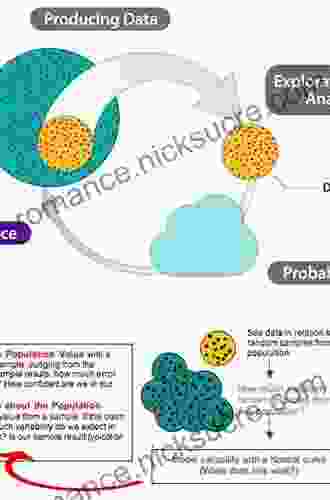
 Jarrett Blair
Jarrett BlairUnlocking Statistical Inference through the Lens of Data...
In today's data-driven...
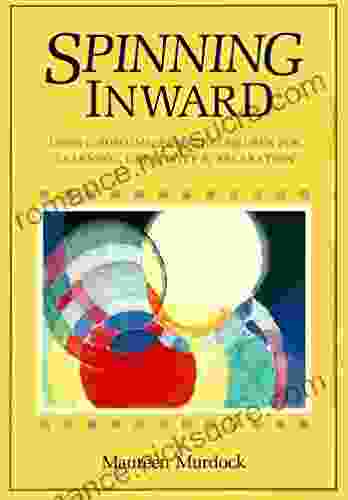
 Frank Butler
Frank ButlerSpinning Inward: A Journey of Self-Discovery and...
Maureen Murdock's book, Spinning Inward:...
5 out of 5
| Language | : | English |
| File size | : | 1056 KB |
| Text-to-Speech | : | Enabled |
| Screen Reader | : | Supported |
| Enhanced typesetting | : | Enabled |
| Print length | : | 90 pages |


